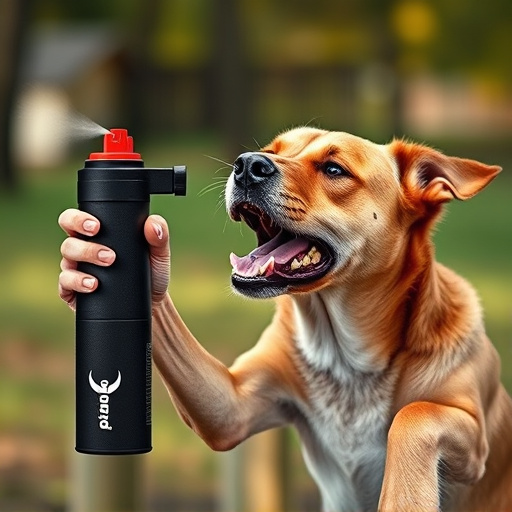Canine aggression, driven by fear or trauma, poses risks. Modern pepper spray with Safety Features in Canine Repellent offers a humane, effective solution. These repellents temporarily impair dogs' ability to smell and react aggressively, ensuring user safety and promoting peaceful coexistence. When selecting pepper spray, prioritize precise application mechanisms, strength, range, automatic shut-off, child-resistance, and local laws. Always use cautiously, prioritizing the dog's well-being.
“Unleashing safety in the face of aggressive dog encounters is a crucial concern for many. Pepper spray, as a non-lethal option, has emerged as a controversial yet potentially life-saving tool. This article delves into understanding canine aggression and its impact, exploring pepper spray’s role as a potent dog repellent. We’ll guide you through key safety features to consider, ensuring effectiveness while mitigating risks. Learn about usage guidelines and best practices to navigate this complex issue, ultimately empowering you with knowledge for responsible protection.”
- Understanding Canine Aggression and its Impact
- The Role of Pepper Spray in Dog Repellents
- Key Features to Consider for Safety and Effectiveness
- Usage Guidelines and Best Practices
Understanding Canine Aggression and its Impact
Canine aggression is a complex behavior that stems from various factors, including fear, territorial instincts, or a history of trauma. When a dog displays aggressive tendencies, it can pose significant risks to both animals and humans, leading to severe injuries. Understanding the underlying causes is crucial in devising effective strategies to manage and prevent such behaviors. In many cases, a combination of training, environmental adjustments, and the use of specialized safety features in canine repellents can help mitigate aggression.
Safety features in canine repellents play a vital role in addressing aggressive dog behavior while ensuring the well-being of both the pet and its surroundings. These products are designed to deter dogs without causing harm or long-term distress, promoting a more peaceful coexistence. Repellents equipped with safety mechanisms, such as trigger-based activation or specific target areas, can be particularly effective when used appropriately, offering a humane solution to manage canine aggression in various settings.
The Role of Pepper Spray in Dog Repellents
In the realm of canine deterrents, pepper spray has emerged as a game-changer, offering an innovative solution for managing aggressive dogs. Beyond traditional repellents, this modern approach leverages the power of capsaicin, the active ingredient responsible for the burning sensation associated with chili peppers. Pepper spray for dogs functions by targeting their sensitive olfactory system, temporarily impairing their ability to smell and react aggressively. This non-lethal method provides a safe and effective way to de-escalate potentially dangerous situations without causing lasting harm to the animal.
The safety features incorporated into modern canine repellents, including pepper spray, are numerous. These products are designed with user safety in mind, featuring triggers that ensure precise application and minimize the risk of accidental exposure. Moreover, they are often formulated to be non-irritating to human skin and eyes, making them suitable for use by pet owners and professionals alike. With proper training and responsible usage, pepper spray can serve as a valuable tool in managing aggressive dog behavior while upholding humane treatment standards.
Key Features to Consider for Safety and Effectiveness
When choosing pepper spray for aggressive dogs, it’s paramount to consider key safety and effectiveness features. Look for products designed specifically for canine deterrents, equipped with precise application mechanisms that minimize off-target effects. This ensures the safety of bystanders and pets while effectively deterring aggressive behavior.
Additionally, pay close attention to the strength and range of the spray. A higher concentration of capsaicin, the active ingredient in pepper spray, delivers a more potent sting, but it’s crucial to balance this with user comfort and control. Consider models offering adjustable nozzle settings or burst modes for versatile use in various scenarios. Look for safety features like automatic shut-off mechanisms post-application and child-resistant designs for added peace of mind.
Usage Guidelines and Best Practices
When considering pepper spray for aggressive dogs, it’s paramount to prioritize safety features in canine repellent. These products are designed to deter dogs without causing lasting harm. Always follow usage guidelines strictly, ensuring you have a clear understanding of the product’s active ingredients, concentration, and safe application methods. Best practices include keeping the spray out of reach of children and pets, wearing protective gear during use, and aiming for the dog’s eyes and nose—areas sensitive to irritants.
Additionally, familiarize yourself with local laws and regulations regarding pepper spray use, as these vary by region. It’s crucial to employ alternative methods first, such as sound deterrents or training techniques, before considering chemical repellents. If using pepper spray becomes necessary, do so cautiously, ensuring the dog’s safety and well-being remain paramount throughout the interaction.
In light of the above discussions, it’s evident that pepper spray can be a valuable tool in managing aggressive dog behavior. When used responsibly and according to established guidelines, pepper spray offers effective protection while prioritizing safety for both humans and canines. Remember that understanding canine aggression is key to successful prevention, and always consider the safety features in any canine repellent to ensure positive outcomes.
